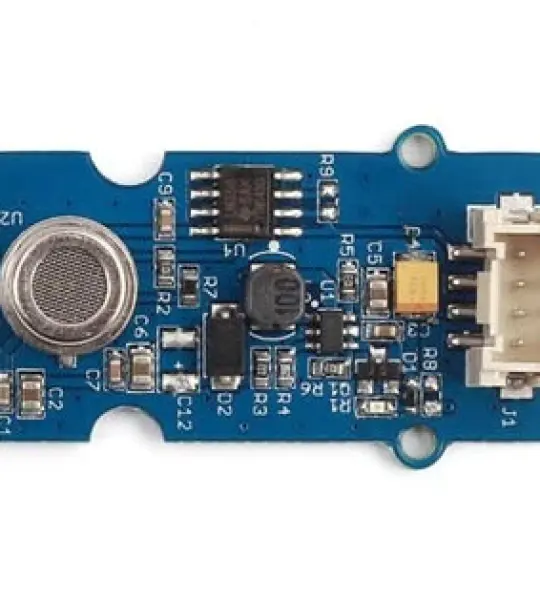Subscribe to the newsletter to receive updates about new products.
A Grove sensor designed for indoor air quality testing.
This sensor is designed for comprehensive monitor over indoor air condition. It's responsive to a wide scope of harmful gases, as carbon monoxide, alcohol, acetone, thinner, formaldehyde and so on. Due to the measuring mechanism, this sensor can't output specific data to describe target gases' concentrations quantitatively. But it's still competent enough to be used in applications that require only qualitative results, like auto refresher sprayers and auto air cycling systems.
Features:
Low power consumption
High sensitivity
Tiny outline
Responsive to a wide scope of target gases
Cost efficient
Durable
Compatible with 5V and 3.3V
Your email address will not be published. Required fields are marked *
Please login to write review!
Looks like there are no reviews yet.
The long awaited BME680 from Bosch gives you all the environmental sensing you want in one small package. This little sensor contains temperature, humidity, barometric pressure, and VOC gas sensing capabilities. All over SPI or I2C at a great price!
Like the BME280 & BMP280, this precision sensor from Bosch can measure humidity with ±3% accuracy, barometric pressure with ±1 hPa absolute accuracy, and temperature with ±1.0°C accuracy. Because pressure changes with altitude, and the pressure measurements are so good, you can also use it as an altimeter with ±1 meter or better accuracy!
The BME680 takes those sensors to the next step in that it contains a small MOX sensor. The heated metal oxide changes resistance based on the volatile organic compounds (VOC) in the air, so it can be used to detect gasses & alcohols such as Ethanol, Alcohol and Carbon Monoxide, and perform air quality measurements. Note it will give you one resistance value, with overall VOC content, but it cannot differentiate gasses or alcohols.
Please note this sensor, like all VOC/gas sensors, has variability and to get precise measurements you will want to calibrate it against known sources! That said, for general environmental sensors, it will give you a good idea of trends and comparisons. We recommend that you run this sensor for 48 hours when you first receive it to "burn it in", and then 30 minutes in the desired mode every time the sensor is in use. This is because the sensitivity levels of the sensor will change during early use, and the resistance will slowly rise over time as the MOX warms up to its baseline reading.
For your convenience, we've pick-and-placed the sensor on a PCB with a 3.3V regulator and some level shifting, so it can be easily used with your favorite 3.3V or 5V microcontroller. All of the pins of the BME680 are available on standard 0.100”/ 2.54mm pitch headers for use with a breadboard. Should you wish to avoid soldering, we now also include our Stemma QT connectors (SparkFun Qwiic compatible). Using these handy connectors you can simply plug in the sensor, no soldering required! QT Cable is not included, but we have a variety in the shop
While you're here, why not also check out the Adafruit BME688 - Temperature, Humidity, Pressure and Gas Sensor - STEMMA QT
The long awaited BME680 from Bosch gives you all the environmental sensing you want in one small package. This little sensor contains temperature, humidity, barometric pressure, and VOC gas sensing capabilities. All over SPI or I2C at a great price!
Like the BME280 & BMP280, this precision sensor from Bosch can measure humidity with ±3% accuracy, barometric pressure with ±1 hPa absolute accuracy, and temperature with ±1.0°C accuracy. Because pressure changes with altitude, and the pressure measurements are so good, you can also use it as an altimeter with ±1 meter or better accuracy!
The BME680 takes those sensors to the next step in that it contains a small MOX sensor. The heated metal oxide changes resistance based on the volatile organic compounds (VOC) in the air, so it can be used to detect gasses & alcohols such as Ethanol, Alcohol and Carbon Monoxide, and perform air quality measurements. Note it will give you one resistance value, with overall VOC content, but it cannot differentiate gasses or alcohols.
Please note this sensor, like all VOC/gas sensors, has variability and to get precise measurements you will want to calibrate it against known sources! That said, for general environmental sensors, it will give you a good idea of trends and comparisons. We recommend that you run this sensor for 48 hours when you first receive it to "burn it in", and then 30 minutes in the desired mode every time the sensor is in use. This is because the sensitivity levels of the sensor will change during early use, and the resistance will slowly rise over time as the MOX warms up to its baseline reading.
Adafruit MiCS5524 CO, Alcohol and VOC Gas Sensor Breakout
Are you sure you want to remove this product from cart?
